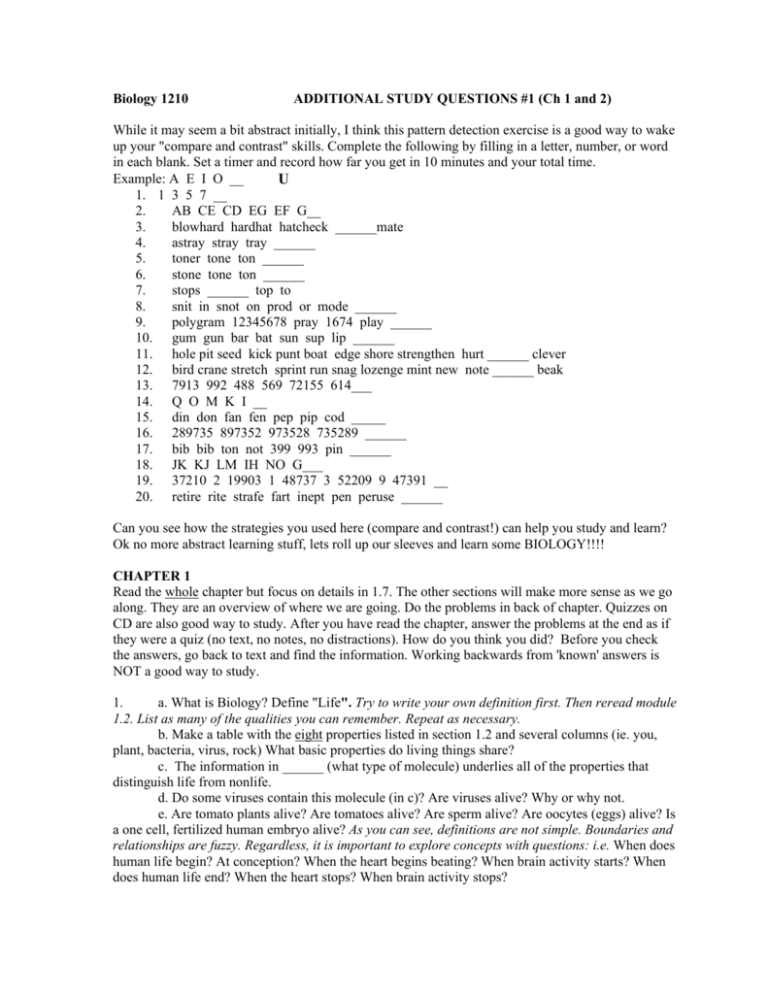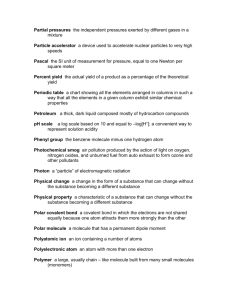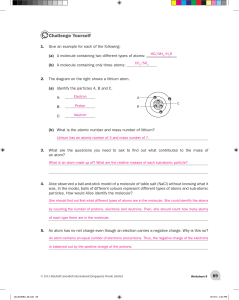Biology 1210 ADDITIONAL STUDY QUESTIONS #1 (Ch 1 and 2
advertisement

Biology 1210 ADDITIONAL STUDY QUESTIONS #1 (Ch 1 and 2) While it may seem a bit abstract initially, I think this pattern detection exercise is a good way to wake up your "compare and contrast" skills. Complete the following by filling in a letter, number, or word in each blank. Set a timer and record how far you get in 10 minutes and your total time. Example: A E I O __ U 1. 1 3 5 7 __ 2. AB CE CD EG EF G__ 3. blowhard hardhat hatcheck ______mate 4. astray stray tray ______ 5. toner tone ton ______ 6. stone tone ton ______ 7. stops ______ top to 8. snit in snot on prod or mode ______ 9. polygram 12345678 pray 1674 play ______ 10. gum gun bar bat sun sup lip ______ 11. hole pit seed kick punt boat edge shore strengthen hurt ______ clever 12. bird crane stretch sprint run snag lozenge mint new note ______ beak 13. 7913 992 488 569 72155 614___ 14. Q O M K I __ 15. din don fan fen pep pip cod _____ 16. 289735 897352 973528 735289 ______ 17. bib bib ton not 399 993 pin ______ 18. JK KJ LM IH NO G___ 19. 37210 2 19903 1 48737 3 52209 9 47391 __ 20. retire rite strafe fart inept pen peruse ______ Can you see how the strategies you used here (compare and contrast!) can help you study and learn? Ok no more abstract learning stuff, lets roll up our sleeves and learn some BIOLOGY!!!! CHAPTER 1 Read the whole chapter but focus on details in 1.7. The other sections will make more sense as we go along. They are an overview of where we are going. Do the problems in back of chapter. Quizzes on CD are also good way to study. After you have read the chapter, answer the problems at the end as if they were a quiz (no text, no notes, no distractions). How do you think you did? Before you check the answers, go back to text and find the information. Working backwards from 'known' answers is NOT a good way to study. 1. a. What is Biology? Define "Life". Try to write your own definition first. Then reread module 1.2. List as many of the qualities you can remember. Repeat as necessary. b. Make a table with the eight properties listed in section 1.2 and several columns (ie. you, plant, bacteria, virus, rock) What basic properties do living things share? c. The information in ______ (what type of molecule) underlies all of the properties that distinguish life from nonlife. d. Do some viruses contain this molecule (in c)? Are viruses alive? Why or why not. e. Are tomato plants alive? Are tomatoes alive? Are sperm alive? Are oocytes (eggs) alive? Is a one cell, fertilized human embryo alive? As you can see, definitions are not simple. Boundaries and relationships are fuzzy. Regardless, it is important to explore concepts with questions: i.e. When does human life begin? At conception? When the heart begins beating? When brain activity starts? When does human life end? When the heart stops? When brain activity stops? 2. see pages 2 & 16 Into what three domains do biologist classify living organism? (Sounds like a jeapordy question!) Prokaryotes are in which domain(s)? Which two domains contain only one kingdom? How are those two domains different from the third? (We will learn how they are different from each other later.) What are the kingdoms in Eukarya? Keep your answers to 1 & 2 in view as you learn more this semester. Use them as a starting point for concept diagrams. 3. *a.. Put the following terms in order from smallest to largest: 1 Atoms ___ Organ ___ Biosphere ___ Organ system ___ Cells ___ Organelle ___ Community ___ Organism ___ Ecosystem ___ Population ___ Molecule _5_ Tissue "*" means this would be a good test question. You will see this one several times. b. On a separate page rewrite the terms in order from smallest to largest level of organization, define each term and give an example. (a good way to study) c. If we observe a koala eating eucalyptus leaves we can hypothesize about the following (match each to the proper level, not all used). i) cellular ___ why it chooses that food ii) community ___ how it digests that food iii) ecosystem ___ how abundant is that food iv) organ ___ how it extracts energy from that food v) organismal *4. Extrapolating from general premises to specific predictions is a kind of logic called a.. induction d. experimentation b. synthesis e. observation c. deduction *5. Deriving general principles from specific results is a kind of logic called a.. induction d. experimentation b. synthesis e. observation c. deduction *6. An educated guess posed as a tentative explanation is called a a. theory d. prediction b. control e. hypothesis c. variable *7. Answers can be used more than once or not at all, some phrases may match more than one term. a. atom ____ gradual change and separation of populations into new species over time b. cell ____ all living things are made of one or more c. evolution ____ a unified set of principles explaining something about the natural world. d. experiment ____ unifying principle of biology e. hypothesis ____ basic unit of matter f. theory ____ test of a hypothesis *8. What is the relationship between a theory and a hypothesis? Can a hypothesis be verified? Can it be falsified? CHAPTER 3 9. *a.. Put the following terms in order from smallest to largest: Atom (H) ___ Molecule (H2) ___ Electron ___ Neutron ___ Element (blimp full of H2) ___ Proton *b. Contrast atoms and elements. Can you see that I can't ask, How big is an element because you can have a little or a truck full. *c. Are any of these terms in "a" alive? Would life exist without them? *d. Which of the above categories is water? Which is DNA? Which is oxygen? *10. a. What is an emergent property? b. List and explain the emergent properties of water. c. Because water is a _____________ molecule, ___________ bonds form readily. *11. Match the following, answers may be used more than once or not at all. a. atom ___ differs in number of neutrons from other atoms of its type b. electron ___ found in the nucleus c. element ___ has gained or lost electrons d. ion ___ has charge and mass e. isotope ___ has charge but (almost) no mass f. neutron ___ determines interactions between atoms g. proton ___ determines identity of atom ___ found in nucleus, has no charge ___ can decay to make one proton and one electron ___ made of protons, neutrons and electrons *12. Which of the following has the least amount of mass? a. proton b. neutron c. electron d. atom e. molecule *13. Atoms can have a maximum of _____ electrons in their inner shell, and ____ electrons in their out shells. Carbon has six electrons. How many covalent bonds can it form? Don't just memorize! Show you calculated this. *14. Match the following, answers may be used more than once or not at all. a. buffer ___ arranged into units called genes. b. carbohyrate ___ the molecule of heredity. c. DNA ___ there are two types: RNA and DNA d. glycogen ___ a polymer of sugar molecules e. hydrophilic ___ a polymer of amino acids f. hydrophobic ___ cholesterol is an example of this type of macromolecule g. lipid ___ how plants store energy h. nucleic acid ___ gain of electrons i. nucleotide ___ starch, glycogen, chitin and cellulose are examples j. oxidation ___ not a true polymer k. pH ___ loss of electrons l. protein ___ a measurement of H+ concentration m. reduction ___ how animals store energy n. starch ___ the monomer unit of nucleic acids (see glossary for definitions of oxidation and reduction, we didn't use those terms yet) *15. When an electron loses energy it: a. flies away from the atom b. donates that energy for the bonding of atoms into molecules c. moves up to the next energy level (one further wasy from the nucleus) d. moves down to the next energy level (one closer to the nucleus) e. loses the potential energy it once contained 16. List three types of bonds described in this chapter and the type of atom interactions involved. 17. Compare and contrast the following: a. polar/nonpolar b. element/matter c. inert/reactive d. DNA/RNA 18. Which of the following best describes the "rules" for solutions? a. opposites attract b. Only solids can be solvents c. Like dissolves like. d. Only solids can be solutes. e. None of the above. 19. A solution of pH 6 contains ______ H+ than the same amount of solution at pH 8. a. 2 times less d. 2 times more b. 4 times less e. 4 times more c. 100 times less f. 100 times more 20. Which of the following is NOT a chemical reaction? a. Sugar and oxygen gas combine to form carbon dioxide and water? b. Sodium metal and chlorine gas unite to form sodium chloride. c. Hydrogen gas combines with oxygen gas to form liquid water. d. Solid ice melts to form liquid water. e. Sulfur dioxide and water vapor join to form sulfuric acid. 21. Animals obtain energy through a series of chemical reactions in which sugar (C6H12O6) and oxygen (O2) are reactants. This process produces water (H2O) and carbon dioxide (CO2) as waste products. Suppose you wanted to find out whether the oxygen in CO2 comes from sugar or oxygen gas. How might you find out? (Hint: number of neutrons) 22. List the biological issues that you have heard about in the news last week. (This might be a good bonus question). Now pay attention and keep a list of biology stories in the news. This is a good way to figure out what you think is interesting, important etc. As the semester progresses, hopefully you will notice more and more. (I'll put a key at reserve desk and electronic reserve but sometimes it takes a few days…to prevent working backwards from answers!)







